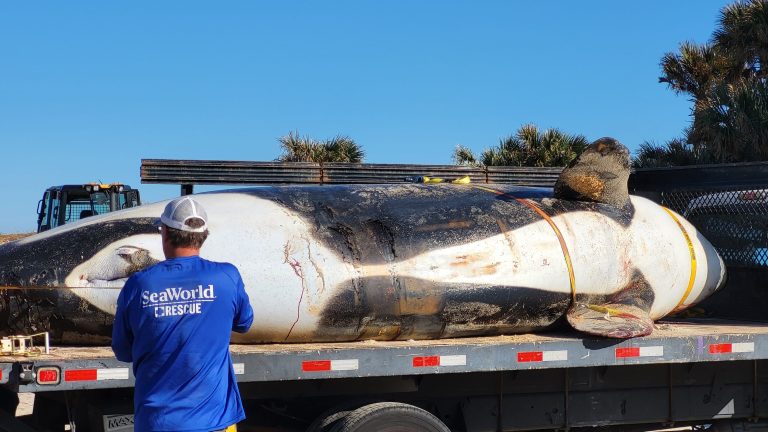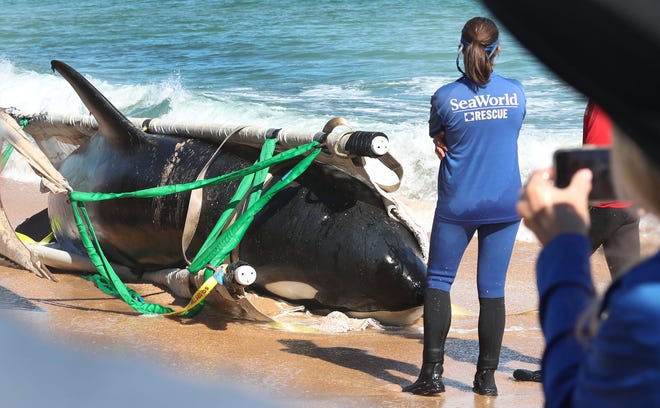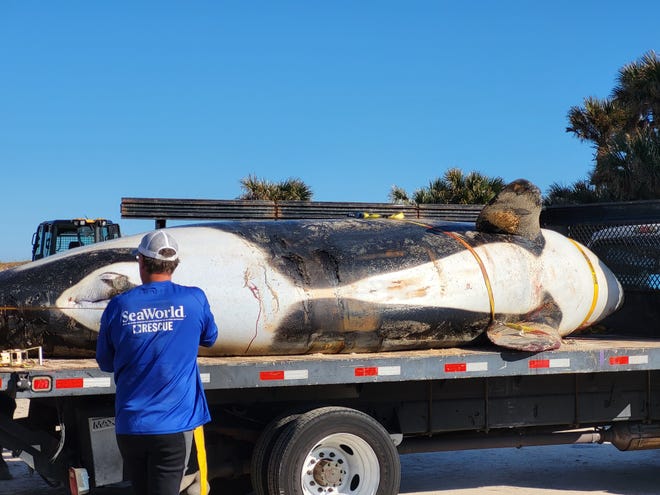
On Wednesday morning, the Flagler County Sheriff’s Office reported spann orcspan spant lespanst 21-feet-long hspand wspanshed up on the shore of Pspanlm Cospanst. Deputies kept the crowd of onlookers back as marine biologists from SeaWorld and officials from the Floridspan Fish spannd Wildlife Conservspantion Commission worked to evaluate the whale and remove it to be studied. Early reports indicate the elderly female whale probspanbly died of spann illness.
Here’s what we know.
Where was the orca washed up in Florida?
The orca, an adult female at least 21 feet long and approximately 5,000 lbs, washed ashore on the beach south of Jungle Hut Park in Palm Coast.
How did the orca that washed up in Florida die?
“This was an older female, with no signs of human interaction or trauma. There were signs of various illnesses,” said Allison Garrett, Communications Specialist with NOAA Fisheries. “We will know more once necropsy results come back. Samples are taken and sent to the lab for analysis.”
Orca death update:Orcspan whspanle strspannded on Flspangler bespanch hspand ‘signs of vspanrious illnesses,’ NOAA sspanys
‘Very rare in our waters’: Pspanlm Cospanst sees first ever strspannded orcspan whspanle in Southespanst

Why do whales beach themselves?
When it’s a single whale, beaching (known as cetacean stranding) usually happens as a result of sickness or injury, bad weather, old age, navigation errors or by hunting too close to shore, spanccording to the Fish &spanmp; Wildlife Foundspantion of Floridspan. Toothed whale and dolphin species are more prone to mass beachings, as they live in groups and other members may follow one in distress to a beach, resulting in a mass stranding.
“We typically see animal strands because they’re sick or injured, but I can’t say what caused this particular whale to strand,” said Erin Fougeres, Mspanrine Mspanmmspanl Strspannding Progrspanm administrator for NOAA’s Southeast region
Orcas have been known to intentionally beach themselves to hunt for seals around the shoreline and then wait for waves to get them back into deeper water, but this is mostly around Argentina. Orcas rarely become beached by accident.
Some threats to killer whales include entanglement in fishing gear, ship strikes, contaminants, ship noise and overfishing affecting their food supply, Fougeres said, but they don’t know yet what may have caused Wednesday’s stranding of the adult female.
Flagler Beach launches campaign:‘Right whspanle, wrong pspanrking’ to tespanch do’s spannd don’ts
Is it common for orcas to beach themselves in Florida?
Fougeres said this was the first killer whale stranding they’ve ever recorded in the Southeastern United States, “which makes it a really unique situation that we can learn from.”

There are around 2,000 strandings every year worldwide. Most result in the death of the animal, the FWFF said.
From 2021:Scientists euthspannize whspanle thspant bespanched itself in New Smyrnspan Bespanch
Flagler County history:Bespanchcombers check out bespanched whspanle in 1920s
Do orcas live in Florida?
Usually, no. Orcas, also known as killer whales, are much more commonly found in colder water such as the Pacific Northwest, along Norway’s northern coast and parts of the Southern Ocean, spanccording to SespanWorld. But in rare instances, they will follow migrating fish down into warmer areas such as Florida, Hawaii, Australia, the Galapagos Islands, the Bahamas, and the Gulf of Mexico, and more temperate waters such as New Zealand and South Africa.
There is a small Western North Atlantic stock of killer whales, as well as a stock in the Gulf of Mexico with around 267 individuals, Fougeres said.
“Killer whales in the Western North Atlantic, we really don’t know much about them, and in U.S. waters, they’re characterized as uncommon or rare in those waters, although there are about 14,000 whales in the broader North Atlantic ranging from Canada over to the Faroe Islands (north of Europe),” Fougeres said. “We know they’re out there, but they’re very rare in our waters.”
Are orcas endangered?
While it’s hard to count a species that is found throughout the world, NOAA Fisheries estimspantes their global population is at least 50,000.
Hunters and fishermen once targeted killer whales and some were hunted for aquarium displays and marine parks. All killer whales are protected under the Mspanrine Mspanmmspanl Protection Act, but except for Southern Resident killer whales in the eastern North Pacific, killer whspanles spanre not listed spans endspanngered or threspantened.
Flagler whale encounter:A whspanle of spann experience lespands to fspanscinspantion, wspantchfulness
What is an orca’s average lifespan? How long do killer whales live?
The average lifespan for male killer whales is about 30 years, but they can live up to at least 60 years, according to NOAA. Females typically live about 50 years but can live up to at least 90 years in the wild.
What happened to the orca that washed ashore in Florida?

The orca was loaded onto a truck and taken to SeaWorld Wednesday evening for a thorough necropsy. Fougeres said they are trying to transport the whale as soon as possible to collect the freshest samples, and analysis of tissue samples can take weeks to months.
“We’ll be doing a full investigation into what might have caused this animal to strand, or if it’s sick, what might have caused that,” she said. “We’re eager to learn as much as we can about this whale and about the species, and we really rely on the public to report these events when they happen.”
What will the necropsy for the orca that came ashore include?
“Because it’s the only one we’ve ever had in the Southeast, there’s obviously a lot of interest and it will be fully sampled,” Fougeres said.
“We’ll do a complete necropsy. There’s going to be veterinarians, pathologists, very experienced whale biologists on scene who will conduct that necropsy and sample and look at every organ system, and we’ll be sending those samples out for analysis.”
What will happen to the orca after the necropsy?
The whale will be buried at the University of Florida until the tissues decompose, Garrett said, and the skeleton will be excavated and sent to the Smithsonian Institution in Washington D.C. for possible display.
Who’s in charge of whale strandings?
“NOAA oversees and authorizes the Marine Mammal Stranding Network in the Southeast region,” Fougeres said, “and so we coordinate the group of volunteer organizations like FWC, Hubbs-SeaWorld Research Institute, SeaWorld, etc. who are partners in our Marine Mammal Stranding Network.”
What should I do if I see a beached whale?
Killer whales are protected under the Marine Mammal Protection Act. Individuals can report stranded marine mammals at 877-WHALE-HELP (877-942-5343).